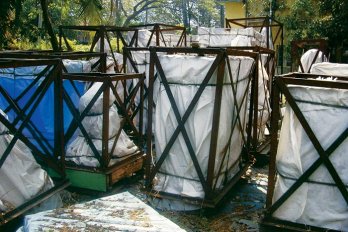lomako forest—On the muddy bank of the Lomako River, in the thick of the Democratic Republic of Congo’s Lomako Forest, a woman in a yellow T-shirt is standing with a baby in her arms. Half a dozen ragged men have swarmed her husband, who’s trying to fight back. The whole scene threatens to explode, as things seem to in this part of the Congo.
There’s the feeble click of an AK-47 misfired by our escort, a rebel soldier. (This territory is controlled by the Movement for the Liberation of Congo, one of the Congo’s two main rebel groups.) The commandant’s faulty weapon can barely be heard over the ruckus.
The Belgian primatologist Jef Dupain is the reason we’re here. Dupain first came to the region a decade ago, spending five years studying the endangered bonobo ape before fleeing ahead of advancing rebels in 1998. Last November, he returned to his abandoned research camp deep in the lush rain forest, this time with our documentary film crew in tow.
Accompanying the thirty-eight-year-old Dupain and the film crew are two fellow conservationists. We are the first group of Westerners in the area since civil unrest erupted five years ago.
Dupain is not alone in his interest in the bonobo, also commonly known as the pygmy chimpanzee, a species unique to the Congo. Complex and deeply intelligent, bonobos share a close biological link to human beings with 98.7 percent of the same genetic makeup. Their distinctive “pansexuality”—sex is used for everything from casual greetings to conflict-resolution—has fascinated researchers who believe it holds clues to the roots of human sexuality.
Dupain and the conservationists are here to see if any of the playful but reclusive apes have survived the war; the film crew is here to follow the researchers’ quest—and explore what it means to focus on the plight of an endangered species in a country in the throes of an ongoing humanitarian crisis. Conservative estimates say 3.3 million people have been killed in this war; some say it’s closer to five million.
It was difficult getting into the dense jungle, which is broken only by the black, watery veins of the river. We travelled upriver in dugout canoes for four days, then continued on foot for four hours through a vast, anarchic wilderness crawling with insects and rebel soldiers armed with rusty assault rifles, filming all the while.
Eventually, we arrived at the research camp, now overgrown with vegetation. But after an initially joyful reunion with locals who had been his research assistants, and many days working together again in the wild looking for apes, Dupain and the group fell out over an old debt.
Dupain had hoped that by initiating further research he would provide a supporting local industry helpful to both the people and the animals—not to mention his own work. But the workers, hungry and fearful, wanted to get what they were owed, before the relatively wealthy outsiders vanished again indefinitely.
The research, too, has proved less than encouraging. We have only had two sightings of the animals the whole time we’ve been here. Dupain fears that the bonobos have been hunted for food by the desperate villagers.
Now, three weeks after our arrival, we have decided to retreat. But getting out is proving hard. During our stay, tension has mounted steadily. Workers from rival villages have been fighting over where the research should take place. At this moment, as we stand on the riverbank, ready to depart, the tension is peaking over the issue of the debt. It’s clear that we won’t be leaving until the workers get their money.
Fearing for our safety, the film crew offers a compromise and pays half of what is owed. But then, workers from the rival villages turn on one another, fighting over the cash.
The family on the riverbank is from another part of the forest, and the workers from this area believe the husband has pocketed more than his share. If we leave the family behind, they could be killed by the small, angry crowd.
In a place like the Congo, guns settle conflicts. Standing in a canoe, facing the decaying cluster of straw huts, the commandant quickly clears the chamber of his weapon, and, this time, the loud, metallic chk-chk gives the villagers pause.
Backed by the commandant and our other military escort, a skinny thirteen-year-old rebel soldier armed with an Uzi, we move out, taking the terrified family with us.
The normally energetic Dupain sits in defeated silence at the front of the canoe as we slide slowly downriver. The camera continues to roll.
For as far back as anyone can recall, the only outsiders with any real interest in the Congo were those bent on spiriting away, at great profit, its vast mineral and natural wealth: rubber under the brutal Belgian colonists and now gold, diamonds, and timber by several equally brutal African armies and militias, both foreign and Congolese.
To ordinary Congolese concerned with survival, the interest in the apes may be just as unpalatable.
This appeared in the October 2003 issue.




